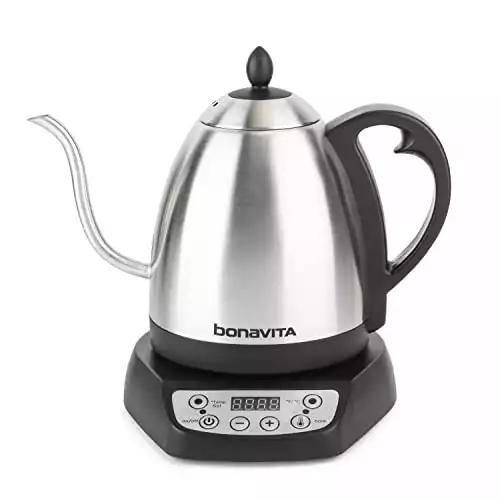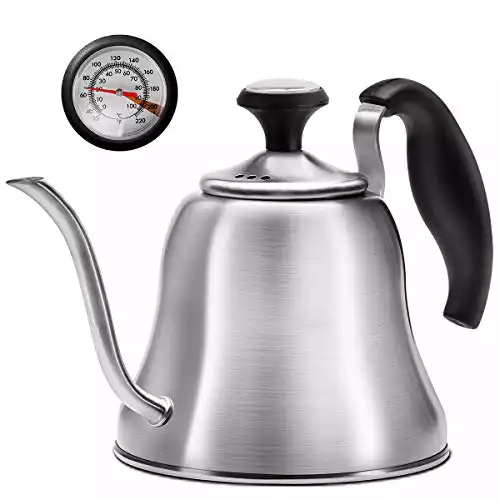Do you need a coffee kettle to make pour-over coffee? Answers to all your questions about electric and stovetop coffee kettles.
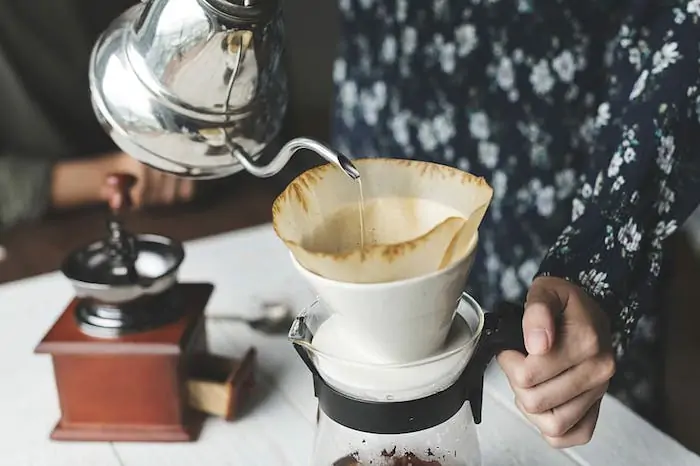
Everybody knows what a tea kettle looks like. Most of us use drip coffee makers every day. However, you might be scratching your head after hearing people refer to something called a coffee kettle.
What on earth is this hybrid contraption that some people swear by for getting their daily java fixes? It’s really not all that complicated. In fact, the simplicity of the coffee kettle may actually add a nice kick to your daily coffee ritual.
What Is A Coffee Kettle And Do You Need One?
It should be said right off the bat that you’ll sometimes hear a coffee kettle referred to as a gooseneck kettle (see Amazon). The two terms are interchangeable. However, calling this item a gooseneck kettle does offer a pretty accurate description of its long, slightly curved spout.
The big reason why you’d want a coffee kettle is if you want to prepare pour-over coffee. There was a time when you really only saw coffee kettles used at fancy coffee shops or French Cafés in large cities. However, more and more people are actually starting to use them at home to create café-level, ultra-quality coffee.
Do you have a lot of questions about coffee kettles? Keep reading to dive into the basics that go along with making the swap from a typical coffee maker to a coffee kettle. We’re also going to discuss how using a coffee kettle differs from other “by-hand” methods for making coffee at home.
Everything You Ever Wanted To Know About Coffee Kettles
Do you love keeping up with coffee trends? It’s possible that you may be missing out on an opportunity to make the best coffee possible at home. Let’s see if we can fix that by going over all of your pressing questions regarding how to get a great java fix at home with a coffee kettle.
A coffee kettle’s signature look is its long, narrow neck. The neck of a coffee kettle is also slightly curved. This is why you will hear it referred to as a gooseneck kettle.
You may be wondering why a coffee kettle has a long, narrow neck that curves slightly. This isn’t just an aesthetic feature. Of course, the distinctive look of a coffee kettle does make it a very nice conversation piece to leave on your kitchen counter.
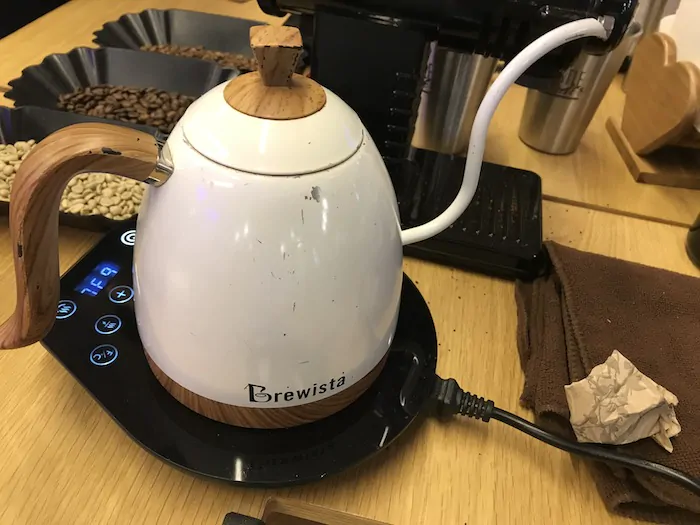
The goose-like neck of a coffee kettle allows you to have greater control over your flow rate when pouring. This allows you to be more precise about the way the water will come into contact with your coffee grounds. The result is simply a better flavor.
You may have noticed that the handle on a coffee kettle actually juts out in a very specific way. As for the long neck, this is also something that’s intentional. In fact, your hand will thank the designer that thought up this setup.
The handle on a coffee kettle is designed to provide you with a comfortable grip that will allow you to make slow, steady pours. The width between the handle and the body of the kettle is carefully measured to make sure your hand doesn’t need to come into contact with the kettle. This creates a safer, more enjoyable pouring process.
Coffee kettles are typically made from stainless steel. Stainless steel is ideal for maintaining the right temperature inside your kettle. It also makes for easy cleaning.
Why Would You Want To Use A Coffee Kettle?
It’s easy to think that something like a coffee kettle is only meant for coffee “snobs.” However, the truth is that kettles are meant for anyone who just really likes good coffee. The main reason to use a coffee kettle is to create pour-over coffee at home.
What is pour-over coffee? This “coffee shop” term is exactly what the name implies. It is coffee that you pour over your grinds.
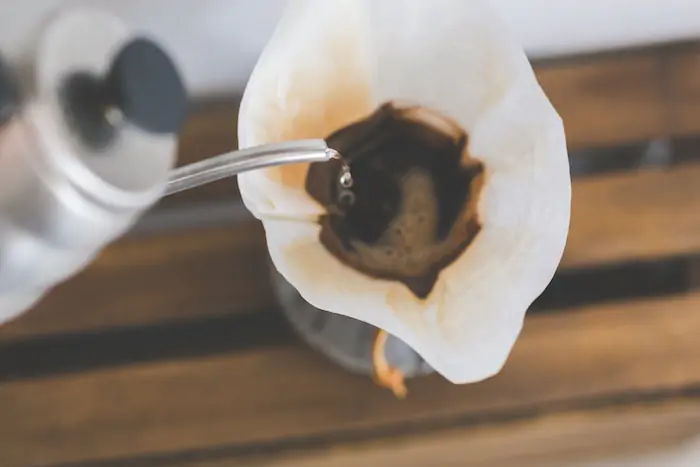
A long-necked coffee kettle provides an opportunity to slowly pour your hot water over your grinds to create a very rich and specific flavor experience. This method gives you the ability to extract a very full-flavored result. You can also very easily control how much coffee you make in one sitting instead of being stuck with a whole pot the way you might be with a standard electric coffee maker.
Yes, the flavor really is the top reason why you’d want to consider using a coffee kettle. Most people report that this method provides a more nuanced and subtle flavor profile than you’d get with a French press or drip machine.
How To Use A Coffee Kettle
Making pour-over coffee is actually brilliantly simple. We’re basically looking at 10 very simple steps that stand between you and a great cup of coffee. Many people love the fact that the process of making coffee is streamlined when you use a coffee kettle because there’s no need for any machinery.
Picking high-quality grounds is always going to be important when making pour-over coffee at home. You will also need to gather a filter, a funnel and a cup to get started. Here’s the basic process of making pour-over coffee at home using a coffee kettle:
- Bring water to a boil in your kettle’s carafe.
- Allow the water to stand for about 30 seconds.
- Measure your coffee grounds at a ratio of 25 grams per 12-ounce cup.
- Place a paper filter in a funnel that’s perched over the lid of your mug.
- Add coffee grounds to the filter.
- Pour the hot water over the funnel using slow, spiraling motions.
- Wait about 30 seconds while the grounds become saturated.
- Resume pouring the water over your grounds using a spiral motion that gradually turns into a straight pour.
- Ensure that your grounds are fully saturated.
- Swirl the coffee in your mug before taking a sip.
- Enjoy!
It is recommended that you get your coffee grounds to the coarseness of sand before using them in your coffee kettle. It’s important to remember that slow pouring is the goal! Rushing through will cause your cup of coffee to be weak and flavorless because the water won’t have a chance to slowly absorb into the grounds.
How can you prepare grounds for slow-pour coffee? You can simply grind fresh beans at home using a standard grinder like this until they reach the level of coarseness you want. There’s also the option to save time by simply purchasing grounds that are already course.
The grounds that you use with your traditional drip coffee maker could be too thick to work nicely with a slow-pour kettle. That doesn’t mean you have to abandon them for something else. You can always simply put the grounds in your own grinder to make them even more refined.
Deciding On An Electric Or Stovetop Coffee Kettle
You have two types of coffee kettles to choose from when creating your personal artisan coffee setup at home. Purists will say that only stovetop kettles will do. However, many people with rushed morning routines are more than happy to use an electric kettle like this that creates a full artisan experience in a short amount of time.
The big benefit of an electric kettle is that you can avoid turning your oven on every time you make coffee. You won’t have to deal with hot burners. This can be a big advantage if you don’t love the idea of keeping an eye on your stove as you try to get ready in the morning.
An electric coffee kettle looks and operates very similarly to a traditional electric tea kettle. You’re looking at a kettle that locks into a base. The base is essentially a heating plate that is fed electricity using a standard plug.
The nice thing about an electric coffee kettle is that you can warm up your water safely on your countertop. Again, you’re avoiding the need to turn on a burner during a rushed morning. Of course, you might be wondering if electric kettles are just as “authentic” as stovetop coffee kettles.
The truth is that finding an electric coffee kettle even just a few years ago was basically unheard of! You really only had the option to go with a classic stovetop version if your goal was to recreate the slow-pour method that is served up at coffee shops at home. It’s really an entirely different story today!
Electric coffee kettles are everywhere these days. The good news is that you are not really sacrificing anything if you go with an electric kettle. Most electric kettles have carafes that look identical to stovetop versions.
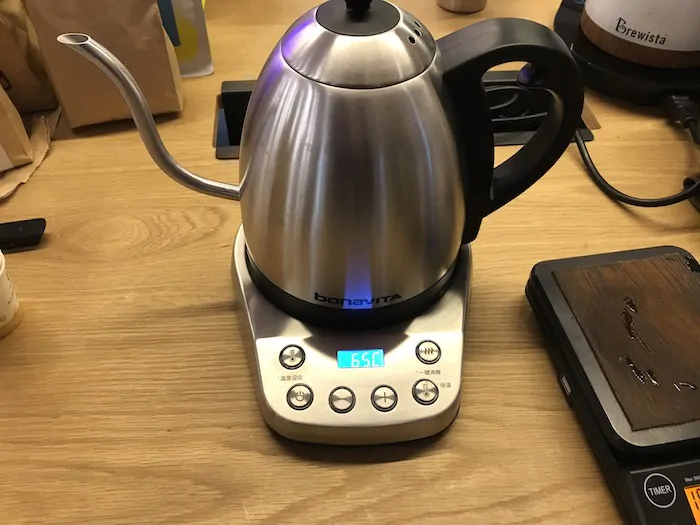
Yes, electric stovetop coffee kettles have that classic “gooseneck” look that coffee kettles are so famous for having. That means that you’re still getting the ability to do a very slow and controlled pour over your grounds. Electric kettles also have that same signature handle that stovetop kettles are famous for having.
The bottom line is that you’re really not sacrificing anything if you opt for an electric kettle out of convenience. The main concern is simply that you’re getting the benefits of the long, curved nose and a handle that will protect your hands from coming into contact with the heat of the kettle’s carafe. Both of those needs are covered by almost every single electric coffee carafe on the market today.
There’s a chance that you simply love the idea of having a beautiful and authentic stovetop coffee kettle in your kitchen. Going the traditional route is a lovely thing. Of course, you won’t be doing something as easy as plugging a kettle in, flipping a switch, and waiting for a buzzer to go off.
The way a stovetop coffee kettle works are very similar to the way a Moka pot works. You’re just going to want to place the kettle on the stovetop until the water boils. It goes without saying that you should always be vigilant while your kettle is on the burner to ensure that you’re not leaving it unattended.
The actual process for making your slow-pour coffee is going to be exactly the same whether you use a stovetop or electric kettle. In fact, a base with a plug is really the only visual difference that is noticeable between the two options.
One added benefit to a non-electric coffee kettle like this is that it provides portability. That extra level of portability means that you’re going to be able to bring your kettle on overnight camping trips. The idea of having some gourmet coffee even though you’re sleeping under the stars in the middle of nowhere does sound pretty appealing!
None of this means that a non-electric coffee kettle has a corner on portability. A kettle with a base is actually a great option if you’re looking for a way to make artisan coffee in someplace like a work breakroom without a stove. You’re really going to have to look at things like your personal preference and your intended usage to determine if you’re better off going with an electric or stovetop coffee kettle.
Do You Need A Coffee Kettle To Make Pour-Over Coffee?
There are many ways to produce a perfectly good cup of coffee without using a coffee kettle. However, it really is worth it to treat yourself if your heart belongs to slow-pour coffee. The reality is that what coffee shops charge for this type of coffee is pretty expensive when compared to an ordinary cup of java.
Do you really want to shell out several dollars per day for an artisan slow-brew coffee? Paying so much just to get a really extraordinary cup of coffee isn’t necessary. What’s more, you don’t have to give up good coffee just because you’re making coffee at home to save money.
You may be tempted to just use an ordinary hot-water kettle to make pour-over coffee at home. This is a bad idea for a few reasons. You simply aren’t going to get that level of control that you’d get from the gooseneck design of a kettle that’s intended for slow-pour coffee.
There’s actually a good chance that you could hurt yourself if you attempt to slowly and methodically pour hot water over grounds using a kettle that simply isn’t designed for this. You almost certainly will not get the correct water speed and ratio while you’re pouring. Trying to improvise simply isn’t worth the hassle or sacrifice in quality.
Investing in a coffee kettle really is an investment in enjoying the best of both worlds. The coffee-loving side of you gets to enjoy the slow-pour experience that is so rich and delicious. The cost-conscious side of you doesn’t have to pay someone to produce your daily artisan cup of coffee!
The answer is that you should have a coffee kettle if you love trying out new ways to create amazing coffee at home. The need for one becomes even greater if you’re already addicted to stopping at your favorite coffee shop for a slow-pour coffee every day. The bottom line is that fans of slow-pour coffee are going to find a coffee kettle to be a very smart and wise investment.
Questions Related To Coffee Kettles
Anyone outside of a trained barista may need some help understanding coffee kettles. People who are trying out coffee kettles for the first time often have questions about kettle performance. Let’s dig in to help you clear up your unanswered questions.
What Is the Right Water Temperature for Coffee Brewing?
The optimal temperature when brewing coffee is between 195 degrees Fahrenheit and 205 degrees Fahrenheit.
Is a Coffee Kettle the Same Thing as a French Press?
No, a coffee kettle is not interchangeable with a French press. It’s true that the methods can appear similar at first glance because both involve running hot water through grounds using a filter. However, there are some big differences.
A French press actually relies on a plunger to extract flavor from coffee grounds. What’s more, there is a steeping process involved. This is very different from the slow method of pouring that is involved when making coffee with a coffee kettle.
French press is often much stronger than pour-over coffee. That’s because the grounds are poured through a filter in a way that keeps them away from the finished brew when a kettle is used. The process of making coffee using a coffee kettle is actually a lot closer to the process of simply brewing a cup of tea than it is to using something like a French press.
Does Slow-Pour Coffee Have as Much Caffeine as French Press?
The steeping process involved with a French press creates a final product that has a higher caffeine level than pour-over coffee almost all of the time. Even something like a Moka pot offers a much darker final product because the grounds are placed within the pot.
Of course, pour-over coffee still provides a caffeine fix that is similar to your standard cup of brewed coffee.
